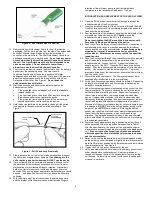
- 2 -
Tortuosity or complex vessel anatomy may affect accurate
placement of the coil.
The long-term effect of this product on extravascular tissues has
not been established. Care should be taken to retain the device in
the intravascular space.
Always advance an appropriately-sized guidewire through the
delivery catheter after deployment to ensure that no part of the coil
remains within the catheter prior to delivering the next coil or
removing the catheter from the patient.
Diagram of Azur System Setup
PREPARATION FOR USE
1.
Refer to the setup diagram.
2.
Select the catheter or microcatheter to be used for coil
delivery. Select a compatible pushing guidewire.
3.
Attach an RHV to the hub of the delivery
catheter/microcatheter. Attach a one-way stopcock to the
side arm of the RHV and connect the flush solution line to
the stopcock. (If fluoroscopic roadmapping is being used, an
appropriate guide catheter with attached RHV and flush
solution line must be incorporated as well.)
4.
Open the stopcock and flush the delivery catheter with sterile
flush solution. Close the stopcock. To minimize the risk of
thromboembolic complications, it is critical that a continuous
infusion of appropriate sterile flush solution be maintained
into the delivery catheter (and femoral sheath, if present).
CATHETERIZATION OF THE LESION
5.
Access the parent vessel or vascular structure using
standard interventional procedures.
6.
Position the delivery catheter for pushable coil deployment
as close to the target lesions as possible, using standard
technique. Remove the guidewire, if used.
COIL SIZE SELECTION
7.
Measure or estimate the size of the vessel or lesion to be
treated.
8.
Select appropriately sized coils. The diameter of the first
and second coils placed should never be less than the
diameter of the vessel to be treated or less than the neck
width of the aneurysm to be treated, or the propensity for the
coils to migrate may be increased. For vessel occlusion, it is
suggested that the diameter of the initial coil placed be
slightly larger than the actual vessel diameter to prevent
displacement or migration. For aneurysm treatment, coils
placed within the aneurysm sac must not be larger than the
dome size, or protrusion of the coil from the sac may result.
9.
Correct coil selection increases effectiveness and patient
safety. Occlusive efficiency is, in part, a function of
compaction and overall coil mass. In order to choose the
optimum coil for any given lesion, examine the pre-treatment
angiograms. The appropriate coil size should be chosen
based upon angiographic assessment of the treatment site.
For vessel occlusion, the diameter of the vessel must be
considered. In the case of aneurysms, diameter of the
parent vessel, aneurysm dome size, and aneurysm neck
width must be considered.
NOTE: The coil has an outer layer consisting of a hydrophilic
polymer. As a result, the secondary coil diameter
(dimension ‘A’ on the package label) will increase by
approximately 0.5 mm following full hydration (approx. 20
minutes).
PREPARATION FOR DELIVERY
10. Remove both the coil (in its introducer) and stylet from the
protective pouch.
11. Verify the cap is present and secure on the distal end of the
introducer and that the introducer is free from damage.
If
any damage is observed, DO NOT use the system.
12. Verify the coil is properly positioned in the introducer. If the
coil has migrated proximally into the introducer hub, gently
tap the distal end of the introducer onto a flat surface until
the proximal end is no longer visible in the hub. If it has
migrated distally into the cap, gently tap the proximal end of
the introducer onto a flat surface until the distal end returns
to the tube.
13. Remove the proximal cap from the introducer hub.
14. Fill a 1-cc syringe with saline. Connect the syringe to the
introducer hub. Hold the introducer in a level position and
slowly and gently inject saline until saline emerges from the
vented distal cap. Allow the coil to remain in the introducer
for 3 minutes, leaving the syringe attached. This helps









































